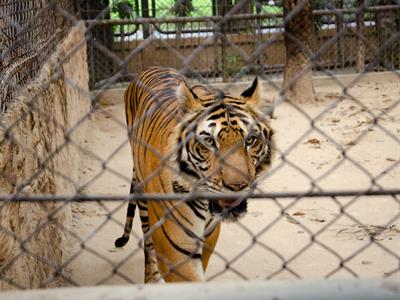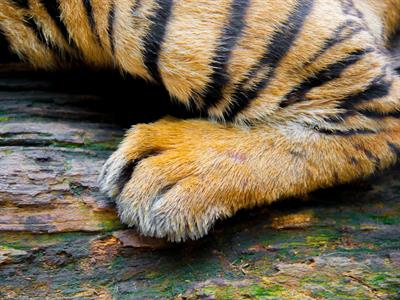PDF chapter test TRY NOW
Earth is habitat to numerous living things other than Human beings. There are animals, insects, and other tiny creatures who have the same freedom to live and enjoy the gifts of nature just as humans do. The poet chooses one among these animals to elaborate on the idea of the distinction between freedom and bondage. In this aspect, the poem discusses the tiger predominantly.

Tiger walking in a cage
The first stanza starts with a rather unconventional action to be attributed to a tiger. Norris says that the tiger is stalking. This word can be associated with the fact that the tiger does not remain meek and is eyeing the happening around him. The entire poem is a personification as the tiger is always addressed as 'Him'. He is given the same prominence as any human being. At the beginning of the poem, he is not in a position to be in his free true self. Although he is not free, he does not submit to the situation and sleeps in a corner waiting to be fed. Rather he stalks around the cage. To stalk is to fiercely pursue something in a very obsessive way. So this shows that the tiger is looking and waiting for the chance to pounce.
He walks in his vivid stripes, as the tiger's stripes do not follow a set pattern. Like the stripes, his walk and plans are also vivid. It is unpredictable, but one can guess it would be vengeful. He measures every step that he takes, showing that he is very discrete and has laid his groundwork. He does not take quick and fast steps, rather they are very few and slow. The poet compares the feet of the tiger with that of velvet, mainly because of the fur and because they are valuable like velvet. The poet also says that the walk is accompanied not by doubts and pondering but by rage. Generally, rage is associated with a loud outburst and violent demeanour. But the tiger has quiet rage, which is even more dangerous, as the outburst can be huge.

Tiger's foot
Every creature born in this world has a purpose of its own and certain characteristics that they follow. Some are born meek, whereas some are born to hunt and prey. In the ecosystem, every individual/creature survive according to the food chain hierarchy. The tiger, by nature, is a wild animal that is made to prey on other smaller animals and live in a particular way. But being caged has disrupted the entire flow of his life. The poet sums up the list of things that the tiger would have done if at all it was free.
The second stanza lists out the fact about the possible things or the events that could have unfolded with respect to preying. The tiger would have easily been lurking behind shadows. Wild animals have a particular pattern of hunting. The initial step is that they do not reveal themselves in the light. They are mostly found near water bodies, as every animal in the jungle has to quench its thirst and comes near a lake or river to drink water. Animals like deer, which are not carnivorous, would roam around near the water bodies in search of reeds as well. But they can be very swift, and once they sense the slightest danger, they would flee. For this reason, the tiger lurks in the shadows of great trees, waiting for the opportunity. They slide as smooth as slime amidst the grass blades and, when the deer does not suspect at all, pounces on it. The tiger whose place should have been near the water hole is now in the cage.

Tiger eyeing its prey near water hole
People build their houses and other dwelling areas by cutting across jungles. Now, these forests are home to thousands of animals. But humans make them flee from their own homes, thereby getting comfortable. The animals, therefore, have no place to go and therefore intrude the human space. Rather than understanding the situation, they stone and shoo away any animal that they come across in the vicinity. The tiger is a royal animal, and therefore, if he were free, he would have been snarling around the neighbourhood. He would go to the people who have built houses at the edge of the jungle and scare him by showing them his white fangs and claws. This shows that the tiger is an animal to be clearly scared of, which is probably one of the reasons that he is caged.
The second and third stanzas of the poem detail the possible events and actions that the tiger could have done if he was free. The fourth stanza brings the readers back to the reality that the tiger is still within the cage. He is locked in a concrete cell. The poet uses the word concrete to emphasise the fact that it is not even a cage which is half-open so that the tiger smells and sees the outer world. Rather it is a concrete cell with brick walls that makes it a closed space. A mighty animal like the tiger, whose strength is beyond description, is wasted away for no reason behind a cage. Now he is stalking the length of his cage in the sense that his space is very much restricted within the confines of the cage. Even when we consider the tiger as the strongest animal, his strength does not help in breaking the chains that bound him. This shows that every pride and strength has a limitation. But even in the weakest of the times, there always remains one tiny bit of space/ way where one can show their strength. The tiger does not pay any attention to the visitors, and within the four walls, he is the boss. He blatantly ignores the people who have come to see him making them crave his attention.

Patrol car
The poet describing about visitors and patrol cars gives the space the appearance of the zoo. After having a lot of visitors, the tiger is tired, and the last sound that he hears is the sound of the patrolling cars of the zoo that come to check if everything is in order. The irony is that nothing is in order as they have acted against nature. This is the last thing the tiger hears, and it gives him a sense of nostalgia of his natural habitat. It is night, and he is alone as he is not disturbed by human beings anymore. In this precious alone time, the tiger, who is brilliant and not lesser than any human being, stares at the sky. There is a sense of yearning to go back home, and the stars are the only connecting point because it is common to everyone. He probably wonders if anyone from the forest was looking at the stars at the same time, and this is his way of communication.
